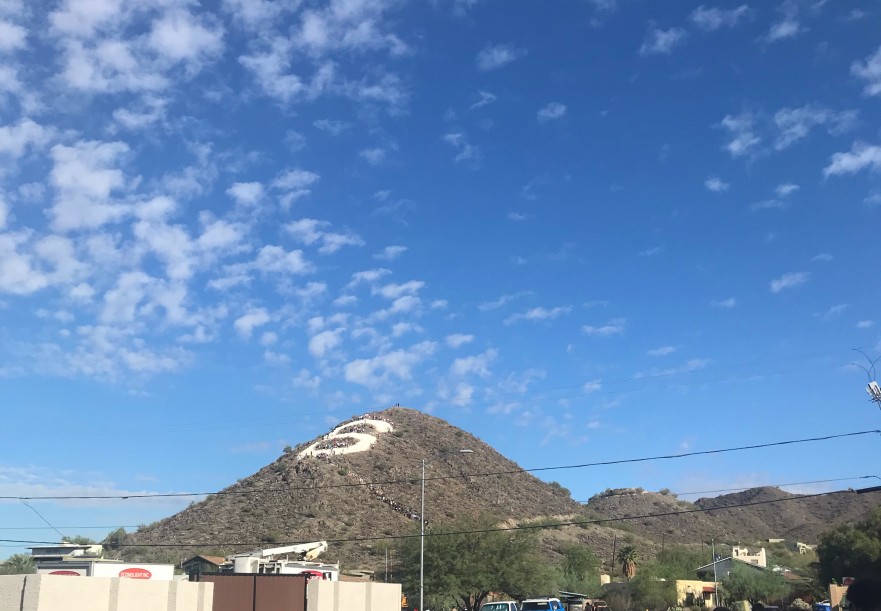Earlier this week, just a few moments after sunrise, I found myself looking down at my school from atop a steep slope. I was pulling weeds, and raking a rocky hillside. No. This was not penance for some classroom stunt. I actually volunteered to be there.
Next week is homecoming at my high school, and that means a slew of student traditions are about to be passed down to the next generation. Teaching in the same room I took AP Literature and Language as a student, and where my senior superlative was “Most Spirited,” this week is kinda a big deal for me.
The week is packed with traditions nearly every day and night. A bonfire. Face painting. Silly-string-visits to classrooms. A Parade, and beyond.
One of the community’s favorite events is centered about a hundred and fifty foot “S” that adorns the face of a looming hill: As the football game ends, the freshmen boys light up flares in the night time. They surround the “S” and the neighborhood glows red.
So this week, I found myself, for the second time in my life, partaking in the less-celebrated tradition: weeding the emblem to reduce fire risks.
I began thinking about why I was so excited to help, the pride I get in all of the traditions my school has, and the importance of building a community through shared traditions. I pondered these notions and was filled with nostalgia. I was prepared to pontificate about the importance of traditions and community in our schools, but I arrived at my keyboard with a question.
In an extreme 180, and in the wake of a year of reflection, I wondered: are traditions an institutional and systematic way that we eliminate individuality and homogenize our youth? This thought crept in my head, and I wondered “do we ask students to embrace our colors, our mascot, and our culture in a way to stamp out diversity and gain ‘sameness’?”
Not to give you too much whiplash, I’d like to slam the breaks again. I realized that would be an oversimplification and crude interpretation of what is occuring. For many reasons, I still think there is a real benefit from strong traditions, strong campus culture, and strong community ties. But I additionally wonder, do we make room for our students to tell us their cultural, or familiar traditions?
I view my diverse school as a blessing. I think there is great benefit that our freshmen come together from multiple school districts and more than 6 different middle schools. The tapestry of cultures, languages, skills, interests, and backgrounds is something for which our school is known.
But, do we celebrate that diversity in our content? In our classrooms? Do we prompt students to share their personal heritage, culture or home traditions? As an English teacher, my students digest news articles, poetry, narratives, and other creative arts. I know that I encourage students to explain how they uniquely perceive or interpret all the media we analyze. So, I know that my students do talk about their perspective, and occasionally mention their backgrounds and cultures as part of their responses. But do I ever explicitly just ask them about their culture?
What makes them unique? And how can we celebrate that diversity?
Hiking “S” Mountain to clean, paint, or light it on fire is a rich part of my life. I looked forward to partaking since I was a child, I relished in it as a student, and I beam with pride teaching and sharing those experiences with students now.
I think about the joy I get from sharing this with students, and I posit my students could get equal excitement telling each other and me about their personal traditions, culture, and heritage.
And despite the whiplash in self-analysis, I think students learning about the school’s traditions AND the people at school learning about students’ traditions is a powerful combination that can only make my class and school’s culture stronger.
Feeling like I solved a lot in typing this post, I additionally wonder if I have given myself a pat on the pack and brushed a true concern under the rug. But I think in posting this, hearing from colleagues and readers alike, I’ll walk out of homecoming week with an even better approach to celebrating traditions, and I’ll have any one who reads this and shared a thought to thank.
So lend me your thoughts in the comments! Does your school have any lovable traditions? Do you solicit students to talk about and celebrate their culture in your classroom? How can we welcome, recognize, and highlight diversity in our spaces?










Comments 3
You bring up some great points, Jay, ones I am going to bring to our district’s Diversity and Inclusion Committee. We have a very diverse population across the district yet we often ask our students to assimilate into a homogeneous view of school spirit.
I love this post! You know I’ve struggled to be the person who oversees the planning and execution of the traditions you wrote about in this post. I believe that traditions are important to creating school culture, but I believe we must evaluate the purpose of the traditions for our students. Some traditions need to be updated to meet the needs of our students today. That may mean changing them or even abandoning them. While that may upset some, out students are not the same as they “were” when traditions were originally created. Our students should be at the forefront of all of planning, school traditions included.
Thanks for the post, James!
I believe it’s important to be aware of and embrace our students’ cultures and diversity. They feel valued and loved when we do. For example, I do a unit on different games from around the world. We played a game called “Fashkhah”, originated in Saudi Arabia, where students jumped over noodles. This made the student from Saudi Arabia so proud. It also gave students an opportunity to look at the map, learn where Saudi Arabia is, and discuss being “open-minded”, our International Baccalaureate trait of the month.